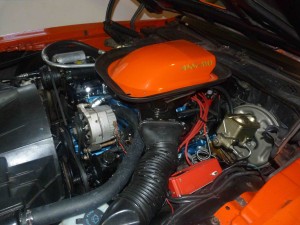A reader pointed out an interesting fact about the current Ford Mustang GT – in relation to the Mustangs of the past. It is that the current Mustang GT weighs just shy of two tons (3,827 lbs) which is about 700 pounds heavier than an ’80s-era Mustang (3,167 lbs. for a 1985 Mustang GT).
Most of that weight being due to government regulations – especially those regarding “safety.” The implication being an ’80s-era Mustang was unsafe – which is silly. It would, however, not be compliant with today’s “safety” standards, which isn’t quite the same thing as “unsafe.”
At any rate, the ’25 GT is really heavy for what it is – that being a “pony” car rather than a muscle car. Those are supposed to be heavy because they are bigger cars – but the Mustang is heavier than many of them, too.
It is heavier than my 1976 Trans-Am and that’s saying a lot. My car – derided when it was new for being overweight – weighs about 3,700 lbs. Less than a new Mustang GT. Even though my ’76 Pontiac has a much larger (7.5 liter/455 cubic inch) V8 engine that’s made entirely of heavy cast iron vs. the entirely aluminum V8 that’s under the hood of the 2025 Mustang GT. That hood is also paper thin such that it can literally be bent by hand while my Trans-Am’s hood (and fenders and door panels) are all made of heavy stamped steel that have to be hit pretty hard to seriously damage.
The Trans-Am also has a heavy cast iron solid rear axle and heavy stamped steel suspension parts such as control arms while much of the current Mustang’s suspension is made of aluminum.
The current Mustang is also a unibody whereas my ’76 Trans Am has a massive bolt-on front subframe that holds the engine and transmission. It also has heavy steel wheels. The Mustang’s are, of course, lightweight alloy.
Yet the Mustang is still heavier than my Trans-Am notwithstanding how much of the Mustang is made of lightweight materials. It is as hilarious as it is sad.
It is also the result of deliberately contradictory federal regs – those demanding ever “safer” (that is, compliant) cars that are at the same time also more “fuel efficient.” You can have the one but not the other. If you want to have both at the same time, it is like expecting to get rid of your belly by eating Big Macs and washing them down with Diet Coke. 
The “safety” regs have porked up new vehicles, which causes them to be less “fuel efficient,” so the vehicle manufacturers try to lighten them up by using as much aluminum and plastic and paper-thin sheetmetal as possible, which serves to make them fragile and expensive to repair and still overweight and not very “efficient,” either. The current Mustang GT’s 18 MPG (average) isn’t much better than what my ’76 Trans-Am manages, now that it has a modern transmission with overdrive gearing – notwithstanding that the TA does not have a modern, fuel-injected engine with computer controls to make the most of every drop of gas. It has a four barrel carburetor. It hasn’t got a computer. And despite that, it still average about 16 MPG. 
The Mustang would probably average much higher – having all the advantages of technology – if it weren’t such a weighty waddler. It would also be even quicker (and faster) and would not need as much power (which is how it’d be able to average much higher).
But we can’t have that – because of government. More finely, because of this weird and tyrannical idea that government bureaucrats ought to be empowered to decree how “safe” and “efficient” the cars we want to buy must buy – and we get to pay for all of that.
At the curb – and at the pump.
. . .
If you like what you’ve found here please consider supporting EPautos.
We depend on you to keep the wheels turning!
Our donate button is here. We also accept crypto (see below).
If you prefer not to use PayPal, our mailing address is:
EPautos
721 Hummingbird Lane SE
Copper Hill, VA 24079
PS: Get an EPautos magnet or sticker or coaster in return for a $20 or more one-time donation or a $10 or more monthly recurring donation. (Please be sure to tell us you want a magnet or sticker or coaster – and also, provide an address, so we know where to mail the thing!)
If you like items like the Baaaaaa! baseball cap pictured below, you can find that and more at the EPautos store!

The bitcoin code is: 3GAfymoqSUbaFvY8ztpSoDKJWCPLrkzAmi if you’re unable to scan the QR code above!











Thought this article would be about the portliness found in a typical LDS ward…
You hit the nail on the head, Eric.
Now, the $64,000 question…
What must we do to get control of OUR auto industry?
When we can figure THAT out…we’ll win the war.
Another bloated fattie….
The slave owners…the master’s stock indices……
Did they sell and are now short?…..They hedge everything…to maintain their wealth….
A strange thing happened…there is signs retail investors were selling recently…they usually go down with the crash…..
The indices look like they are collapsing down through support now….Buy puts??
But…gold,silver, oil and VIX are up…..
https://finviz.com/futures.ashx
Chris Harris and friends podcast…
There is a long discussion on modern overweight cars.
If regulations had gone the other way….forcing manufacturers to focus on building lighter cars…as in a maximum weight for sedans of 1100 kilos…about 2400 lb….that would have killed SUV’s, all overweight EV’s and most hybrids….
Having the roads filled with cars with a maximum weight of 2400 lb reduces pollution…less fuel burnt….less pollution from tire particles…the biggest pollution now….less tire wear….less damage to the road from overweight 5000 lb vehicles….less deaths and vehicle damage caused by huge 5000 lb vehicles crashing into things…..so lower insurance rates….
Europe already had the solution…..many diesel powered 2400 to 2600 lb cars getting up to 60 mpg or more….they banned them…and replaced them with 5000 lb EV’s getting 20 mpg…that cost far more…..1000 steps backwards….
Audi had the best one……The Audi A2 3L – A diesel….The REAL 100 MPG car!
Car only weighs about 1900 lb….the engine only weighs about 200 lb….it can get over 100 mpg and carries four people….the perfect car….
Incentives in insurance rates too….as in lower insurance for lighter cars….as in a 1200 lb Caterham would have very low rates….and far lower insurance and or taxes for cars driven very little…like collector cars….
Also in the podcast…which 3000 U.K. pound…about $3800 U.S. cars will go up in value right now?…..
https://www.youtube.com/watch?v=gZZ3OohCdFw
Lighter more efficient, safer cars…..one example…
The 2014 Volkswagen Golf BlueMotion diesel, capable of a claimed 88.3 mpg imperial, or 73.5 mpg U.S.
it has a 971 mile range, the perfect car.
it weighs 1125 kg, 2480 lb, the new EV’s are over 4000 lb. it weighs 40% less.
Energy density:
In order to go 200 miles the EV had to carry around a 1000 lb battery (some tesla batteries weigh 1800 lb, the hummer battery is 3000 lb.)
In order to go 200 miles the 2014 Volkswagen Golf BlueMotion diesel had to only carry 9.52 lb of fuel.
The 2014 Volkswagen Golf BlueMotion msrp $24,355 U.S., EV’s start at about $45,000
Having driven Miatas as a daily driver for about 20 years, and loving it, I despised heavy cars. Even though my last one only made about 155 HP, it also only weighed about 2400 lbs, so the power to weight ratio was rather high, making it feel like it had more power than that. And definitely handled better than a heavier car with more power.
Every thing the government touches, it makes worse.
ALWAYS!
The sad reality is that even the Miata has gotten heavier due to all the regs. I had a 1991 NA Miata and its weight was just shy of 2000 lbs which was still too heavy.
The sad reality is that modern regs force overweight cars.
The other thing is that American’s (as a generalization) are terrible at designing light weight cars. The subconscious mindset of bigger is better just promotes weight creep.
This is abundantly clear in the hobby forums where people are constantly coming up with “fixes” and “improvements” that massively add weight. It truly is rare to see someone reducing the weight and downsizing components.
Dang it – typo; just shy of 2200 lbs.
“It truly is rare to see someone reducing the weight and downsizing components.”
I don’t think so. In the world of converting stock cars to racing cars, the first thing that’s done is strip everything out of the car that’s not necessary.
Many channels like this one:
https://www.youtube.com/channel/UCYGXns0Ezqd-qKyxMjH-7Pg
His latest series of videos are about converting a 69 Charger into a circle track racecar.
Eric, it’s actually worse than you stated. Because there are THREE competing values, fuel efficiency, “safety”, and emissions.
The “safety” has been transferred from the driver to others by adding weight and structure. But adding 800 lbs of weight adds 70400 lbft of impact energy at 60mph. That’s like being hit with about 28 bullets from a 50 Beowulf at one time. And as noted, it also necessarily costs energy to accelerate and decelerate and run against friction.
The fuel efficiency mandates of course have given excessively complex, expensive systems.
And little noted, the emissions mandates have brought catalytic converters cutting into exhaust efficiency, plus systems are tuned to control combustion temperatures. Efficiency in an IC engine is very closely related to combustion temperatures.
As we say in industry, you can have it good, cheap, and fast. Just pick any 2.
It is depressing to imagine how great cars could be regarding efficiency and reliability if only FedGov would butt the f*ck out. Orange Man keeps listing stuff he’s going to do on ‘day one’, I’m hoping that dumping the CAFE rules is high on that list along with getting rid of the NHTSA and the EPA.
Would also like to see the secret JFK files he promised to release his prior term, not holding my breath on that one.
“I’m hoping that dumping the CAFE rules is high on that list along with getting rid of the NHTSA and the EPA.”
The orange fail will do no such thing.
Even if he wanted to (which I don’t think he does) it’s an impossibility of entrenched interests built around grifting. Then there are all the well meaning voters that believe these three letter agencies are required to keep them safe and to keep the air clean.
Nothing will change.
I’d like to be proven wrong but life experience says this only moves in one direction until it no longer can and the whole system implodes.
Even in the places like USSR / Russia that had a reset, the heavy hand of regulation still continues.
Russia is not nearly as bad as we are.
I’m curious how much of the weight increase is due to requirements relating to higher speeds on the Interstate and how much is due to roll over standards being increased? In the late 60’s the speed limit was 70, perhaps people were just better drivers back then?
“I’m curious how much of the weight increase is due to requirements relating to higher speeds on the Interstate”
Zero
“and how much is due to roll over standards being increased.”
This + new standards for side impact + offset frontal impacts + rear impact + pedestrian impact + etc. . .
Yes. Zero.
The “new” rollover and side impact standards were fully implemented in 11. By 14, when a sizable number of the safety cars were on the highwaya, fatality rates began increasing. Pedestrians have been the most affected due to reductions in outward visibility. The wantin slaughter on the highways was created by NHTSA and aided and abetted by a subpine automotive industry.
“It is also the result of deliberately contradictory federal regs – those demanding ever “safer” (that is, compliant) cars that are at the same time also more “fuel efficient.” You can have the one but not the other. If you want to have both at the same time, it is like expecting to get rid of your belly by eating Big Macs and washing them down with Diet Coke.”
FedGov fiats are full of contradictions. For example, mandate use of solar or wind energy leads to the harvest of solar and wind energy using things that are not biodegradable or recyclable. But, savin’ the planet and all…
‘the ’25 GT is really heavy for what it is’ — eric
During my days as a subway car designer in New York City, we had a weight budget which was estimated at the conceptual design stage. Then it was regularly updated as the car’s structural design was finalized, and the actual weights of subsystems such as propulsion and air conditioning became available from subcontractors. Weight is important in rail transit applications, because heavier cars accelerate rail wear and maintenance.
Do automobiles and light trucks have weight budgets? I don’t know. But unlike mass transit, where the subway car owner also has to maintain the rails, cars run on public roads. Heavier vehicles do more damage to public roads. But who cares, right? It’s what eclownomists call an externality — not Ford’s or GM’s or Stellantis’s problem.
It would be really interesting to compare the weight budget of a 2025 Mustang GT Schweinemobil to its predecessor of 40 years ago. Some components have stayed the same or even gone down in weight. But a whole host of new stuff that wasn’t even used 40 years ago tips the scales back to the ‘excessive BMI’ range.
And yes, you could define an automotive Body Mass Index, based on its weight and footprint. It’s gone up, comrades. Nearly all new vehicles fall into the overweight to obese range. Too much airbag junk food — what a damned shame!
“Do automobiles and light trucks have weight budgets? I don’t know.”
Absolutely.
Everything is related to test weight for fuel economy certification and which bins / tiers the vehicle falls under
There are endless design iterations trying to reduce weight or at least offset weight gains mandated by other requirements (impact, or mandatory new equipment like rear cameras, AEB, etc.)
There are now literally hundreds of pounds of mandated crap that now exists in vehicles (ABS/ESC, airbags, Cameras, radar, emission devices, etc). None of this stuff was mandated in the early 90s.
At least the Mustang beat the Corvette….it is the first American production car to set a under 7 minute Nurburgring lap time…..
Driven by Dirk Müller, a driver for Multimalic Motorsports, the Mustang GTD set a record time of 6 minutes, 57.685 seconds on a 12.9-mile track with fast corners and “The Green Hell.”
The car itself costs around $325,000.
https://www.the-journal.com/articles/ford-mustang-gtd-posts-sub-7-minute-lap-at-nurburgring/
Mustang GTD video….
https://www.youtube.com/watch?v=-0Xg4zxFDHA
The Mustang GT3 car is close to the ideal weight….
If you have $300,000 you can buy a 2024 Mustang GT3 car
600 HP NA V8 powered….weight about 2700 lb…..but no stick shift…..
1966 Mustang around 2800 lb…..about 1000 lb less then some of the 2024’s
https://www.mustangspecs.com/2024-ford-mustang-gt3/
Ford let their road cars turn into overweight screen filled crap….but their race cars are cool….
Fond memories of the GT-R.
2024 Ford Mustang GT3 racing at Spa | BRUTAL V8 Sound and Sparks!
A must see video….
https://www.youtube.com/watch?v=_H0bmLaKtgk
Ford Mustang GT3 Pure American V8 Sound in Action at Monza & Imola Circuits- Best Sounding New GT3?
https://www.youtube.com/watch?v=_AwXHc1tFac
Buy a Mustang GT3 and go GT3 racing…..
GT3 Mustang racing against other GT3 race cars in Europe….
https://www.youtube.com/watch?v=cBxSpawdqvw